
Weekly Market Outlook, U.S. Inflation, Dollar Gains, and Q4 Earnings Reports
Last week in the US ended with impressive labor market data. Earlier in the week, signals of strong performance were already evident, with JOLTs showing about 8 million openings and initial jobless claims at approximately 211,000 for the first week of 2025. These developments boosted the US dollar’s value and lifted Treasury yields, with the US 10-year Treasury Note Yield reaching 4.769%.
In the week ahead, key data releases include December inflation figures (Wednesday), Retail Sales (Thursday), and Housing Starts (Friday).
Outside the US, Chinese inflation numbers provided a positive start to the new year. In Europe, there were also encouraging signs from both the services and production sectors, while Eurozone inflation rose slightly, and Swiss price pressures eased.
In Canada, significant political developments made headlines, with Prime Minister Justin Trudeau stepping down as leader of the Liberal Party. In Latin America, inflation data from Mexico and Brazil presented mixed results.
Looking ahead, important data to watch include UK CPI (Wednesday), Australian Employment (Thursday), and China GDP (Friday).
Earnings Season Kicks Off!
This week marks the kickoff of the Q4 2024 earnings season, starting Wednesday with reports from major players in the banking sector. As usual, these results will set a tone for the broader market, providing key insights into the financial industry’s performance, economic trends, and expectations for the year ahead. Keep an eye on earnings updates for potential market movers! The most important names to watch JPMorgan (JPM), Wells Fargo&Co (WFC), Goldman Sachs (GS), Citigroup (C), Bank of NY Mellon (BK), Taiwan Semiconductor (TSM), UnitedHealth (UNH), Bank of America (BAC), and Morgan Stanley (MS).
USA
Last week, the US labor market report was the main market mover. December employment data highlighted a resilient U.S. labor market, with nonfarm payrolls rising by 256K, significantly exceeding expectations. Over the past three months, payroll growth has averaged 170K, maintaining a steady hiring pace. The unemployment rate dipped to 4.1%, aligning with the Fed’s ideal labor market balance. And lower than the market 4.2% estimates. Wage growth of 3.9% also supports the Fed’s long-term 2% inflation target, as it eased from previous 4% growth.
The Federal Reserve has emphasized that further progress toward 2% inflation is necessary before additional rate cuts occur, provided the labor market remains stable. This solid employment data strengthens the Fed’s confidence but suggests it will adopt a patient approach to rate adjustments. With strong labor data and Fed speakers’ comments during the week, rate cuts by the Fed at the January or March meetings are increasingly unlikely.
In the week ahead, the US inflation numbers on Wednesday will be the main market mover. The December CPI report is expected to show that the underlying trend in inflation is not accelerating again. However, it is unlikely to ease the FOMC’s growing concerns about inflation remaining stubbornly above its target. Headline CPI is projected to rise by 0.4%, following a 0.3% growth in November, driven by a strong increase in energy prices, which can push the annual rate to a five-month high of 2.9%. On the other hand, excluding food and energy, price growth is expected to be more moderate, with the core index likely increasing 0.2%, following four consecutive months of 0.3% gains. If realized, this would keep the year-over-year core inflation rate at 3.3% for the fourth consecutive month. While we do not anticipate a reversal in progress against inflation, we expect progress to stall in the coming year. Earlier disinflationary pressures from supply chain improvements and lower commodity prices have diminished, and new inflationary challenges from trade policies are likely to emerge.
Apart from inflation data, we have the housing market and retail sales as well to watch. Retail Sales numbers are supposed to be published on Thursday, and Housing data on Friday.
Retail Sales (Thursday):
Retail sales exceeded expectations for six consecutive months, with December growth expected to moderate to a solid 0.5%. This would bring annual retail sales growth to approximately 3.4%. High-frequency data suggest a potential upside, as non-store retailers and restaurants saw significant gains in December. The report will provide a complete view of the holiday shopping season, with holiday sales (November–December, excluding auto, gas, and restaurant sales) projected to grow by 3.3% annually, and 0.4% monthly in December.
Housing Starts (Friday):
Residential construction remains mixed. While single-family housing starts were up 7.2% year-to-date in November, multifamily starts were down 27%, impacted by an oversupply of new apartments. Future activity in multifamily construction looks weak, with declining permit filings. In contrast, the single-family market shows resilience, supported by price cuts and incentives despite rising mortgage rates. December housing starts are expected to rise by 2.3% to an annual pace of 1,310K units.
Based on the data, we anticipate a continued downside movement on Wall Street in the coming week, with the US500 targeting 5,700. If this level is reached, the next support levels are expected to be 5,500 and 5,400.
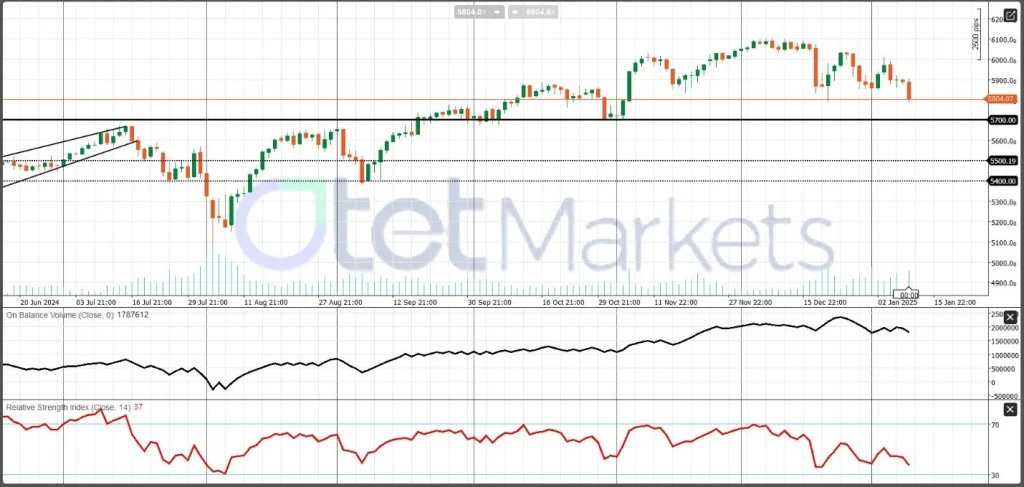
For the US Dollar, the overall bullish trend may persist, but momentum appears to be weakening. Corrections are likely around the 108.50 and 107.80 levels.
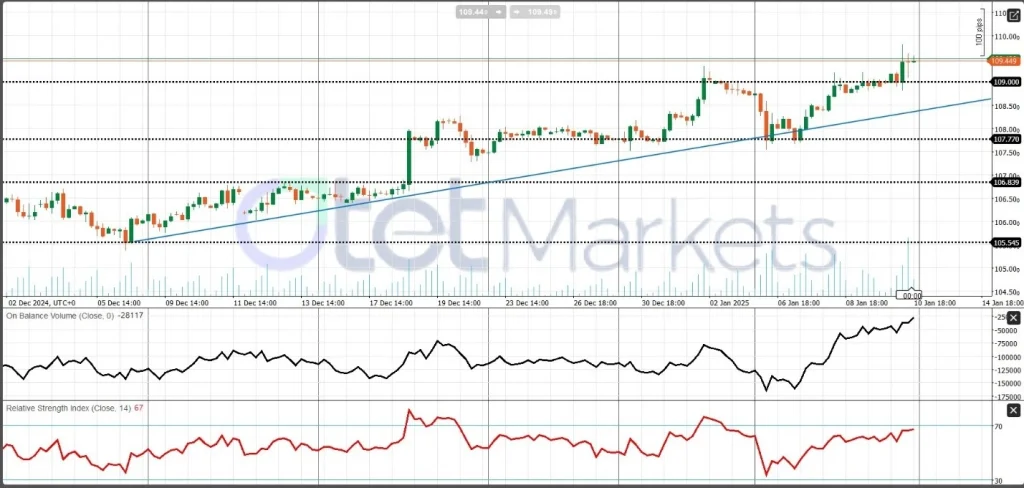
UK and GBP
Political Turbulence continues across the world with increasing opposition to the left wing. A Financial Times report claiming Elon Musk supports the far-right Reform Party ahead of the UK General Election has sparked global attention. The political uncertainty may weigh on the pound, compounded by rising gilt yields, which signal market pessimism about the UK economy. Higher borrowing costs could limit fiscal spending, adding further pressure on sterling.
While tensions about political overview and inflation continue, we are waiting to have more economic data to watch in the week ahead, including December CPI on Wednesday. Headline CPI inflation is expected to remain steady at 2.6% year-over-year, with core inflation slightly easing to 3.4%. After that we have the November GDP numbers on Friday: Monthly GDP growth is forecast at 0.2%, signaling a return to expansion after two consecutive contractions. Stronger-than-expected inflation or growth data could provide temporary support for the pound, forcing traders to adjust their positions. However, continued signs of economic weakness and political instability are likely to keep the pound under pressure.
From a technical perspective, GBP/USD is expected to remain under pressure if it trades below 1.25. If it breaks below S1, the next targets are 1.2030 and subsequently 1.18.
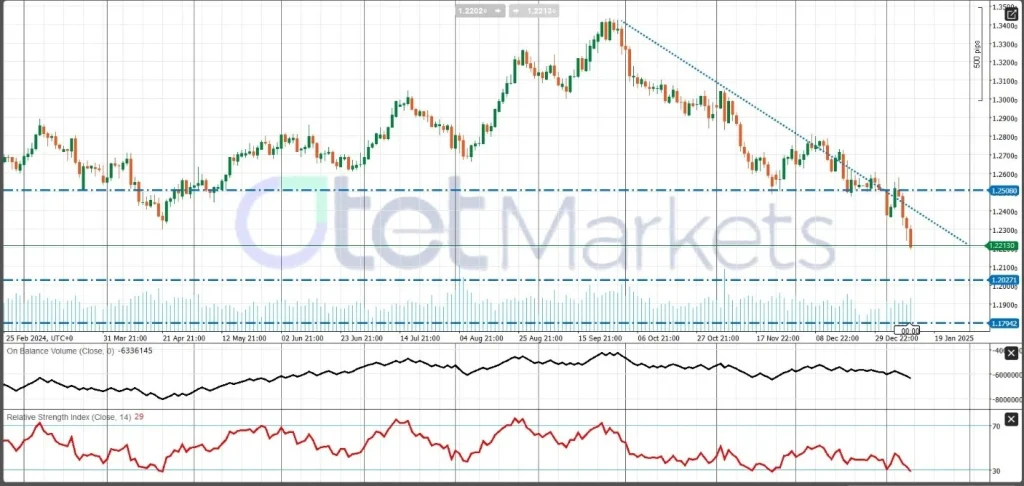
Gold Shines Amid Economic Uncertainty, Despite Dollar Strength
Gold surged to a four-week high last week before paring some gains in the final trading hours. The precious metal has been buoyed by safe-haven demand as investors navigate economic uncertainties and underperformance in stock markets.
Modest safe-haven inflows are helping to offset downward pressure from a stronger dollar and rising interest rates. Market volatility is expected to persist as the inauguration of Donald Trump approaches, creating uncertainty around the new administration’s policies and their potential market impact. Proposed tariffs, if implemented, could spark trade wars and amplify inflationary pressures, potentially boosting demand for gold as a safe-haven asset during economic uncertainty and rising prices.
Meanwhile, the Federal Reserve appears cautious about Trump’s potential policies. Recent meeting minutes highlighted concerns that shift in trade and immigration policies could slow the disinflationary process, delaying a return to the Fed’s inflation target. If the Fed maintains its current base rate of 4.25%–4.5% for an extended period, upward momentum for XAU/USD may be gradual and volatile.
From a technical perspective, XAU/USD remains bullish above the 20-period EMA, with strong support at 2,660 and a target around the 2,700 level for the upcoming week.
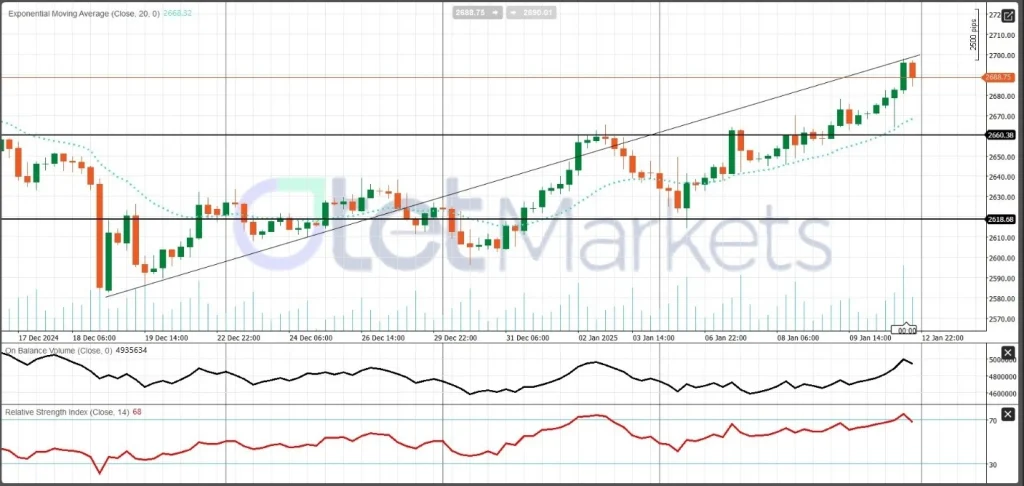
Oil prices are eye on higher digits.
Oil prices are rebounding after a long period of side movement about $70, supported by rising demand driven by weather conditions, manufacturing, and low stocks at the Cushing, Oklahoma delivery point. U.S. crude stocks at Cushing have reached a 10-year low, while overseas demand remains strong. Saudi Aramco has raised the official selling price (OSP) for Arab light for Asia, signaling robust global demand. However, oil prices pulled back after U.S. Secretary of State Antony Blinken indicated a potential ceasefire agreement in the Middle East. However, followed by President-elect Trump’s remarks on hostage situations, which added geopolitical uncertainty, the downside movement could not be so welcomed by investors and market participants. Trump Warns ‘All Hell Will Break Out’ if Hostages in Gaza Are Not Freed. The president-elect did not elaborate yet, on what actions he might take if the captives are not released by the time he takes office.
Natural gas prices -As one of the key Oil price drivers- are also in focus, with the potential for further upside driven by a cold Arctic blast. Winter storm warnings have been issued across several regions in the U.S., raising the likelihood of higher natural gas demand. In Europe and Asia, natural gas prices are soaring, with Asian liquefied natural gas (LNG) prices recently reaching a rare premium over oil, further fueling competition between European and Asian buyers. Cold weather and reduced Russian pipeline flows are contributing to this surge in demand.
While fundamental data supports higher prices, from a technical perspective, bulls still demonstrate enough strength to sustain and hold gains around the $75 level.
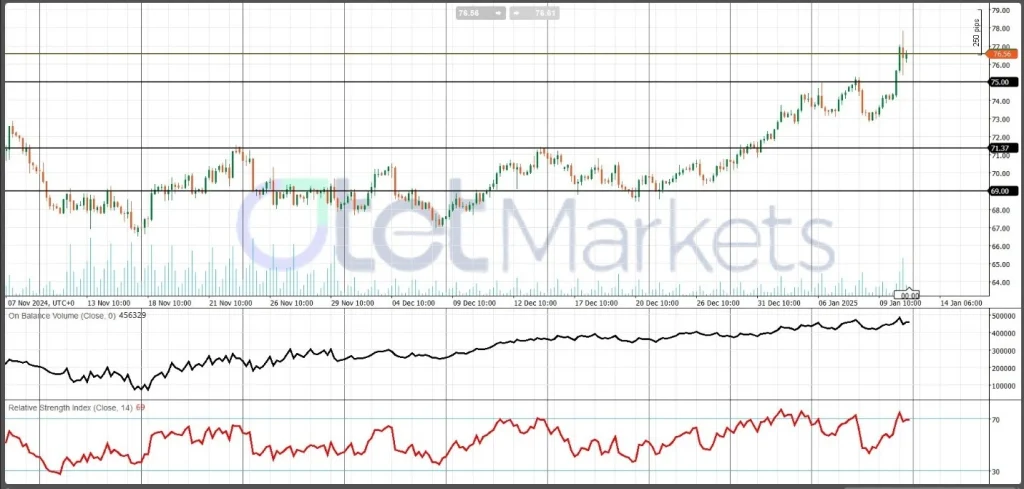
BTC and concerns about the bulls!
Bitcoin started the year with a strong upward momentum, supported by the $92,800 level, which had acted as a solid base during previous consolidations. Early last week, a breakout pushed prices towards 99K, but sellers stepped in near the $100,000 psychological barrier, leading to profit-taking and further pressure from reports of rapid outflows from spot Bitcoin ETFs.
Adding to the bearish sentiment, the U.S. Department of Justice announced plans to liquidate $6.5 billion in Bitcoin seized from Silk Road. This news, coupled with speculation about Donald Trump’s potential return to office—who had previously supported Bitcoin-friendly policies—spooked the market, intensifying the decline.
Macroeconomic factors also contributed to the sell-off. A stronger-than-expected JOLTS report revived inflation concerns, casting doubt on the Federal Reserve’s willingness to implement aggressive rate cuts. Generally, positive employment data and hawkish comments from Fed officials in their speeches across the week, along with a strengthening U.S. dollar, kept downward pressure on Bitcoin.
From the technical point of view, Bitcoin showed signs of correction with strong support at the $92,800 level. On the flip side, to maintain upward momentum, BTC needs to break through short-term resistance levels at $95,800 and $96,500.
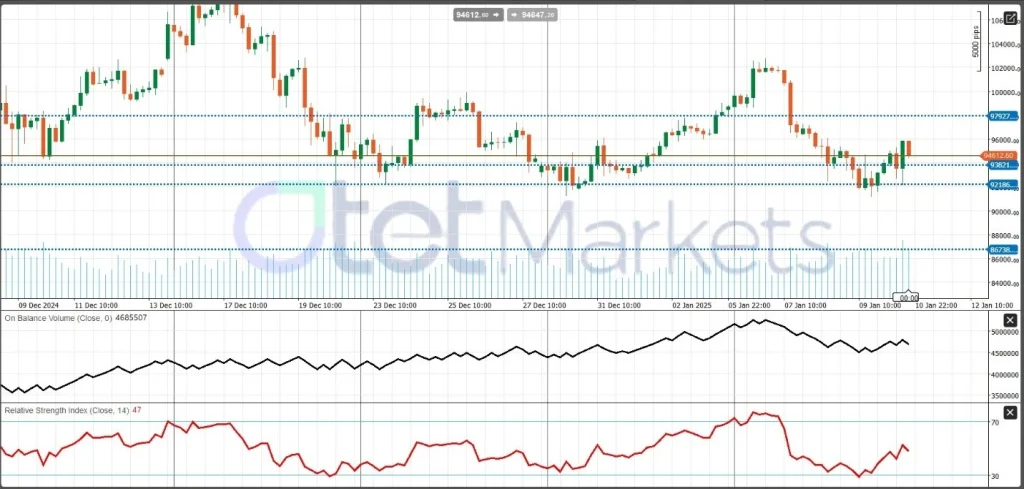
Share
Hot topics

What Is a Market Scanner in Trading?
If you’ve ever logged into your trading platform and noticed hundreds, if not thousands, of choices, you’re not alone. The financial world today moves fast, and with hundreds of charts,...
Read more




Submit comment
Your email address will not be published. Required fields are marked *